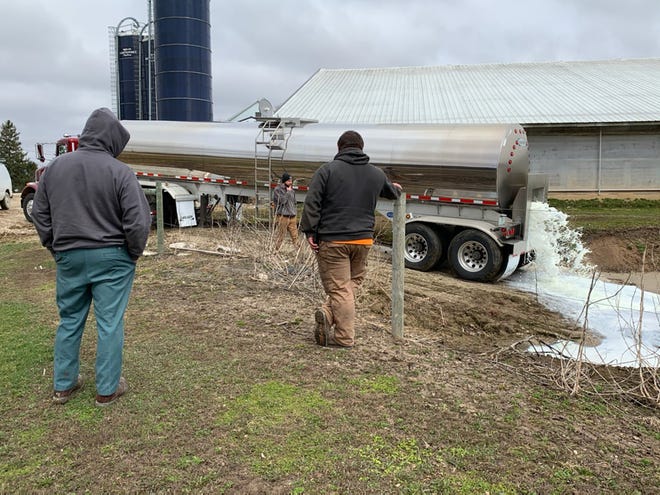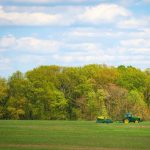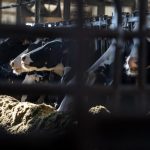
A year later, many food service locations and schools are still closed but the industry has largely adapted to the changes in demand – more people cooking meals at home and using flavorful dairy products to do so. But the supply of milk on farms has grown in the past year and dairy cooperatives and proprietary plants are struggling to handle all of it.
“A couple of Wisconsin dairy processors have told their producers that they are invoking their base/excess pricing formulas,” says Mark Stephenson, Director of Dairy Policy Analysis with the UW-Madison. “There’s a lot of milk out there and so far it’s all been taken. The question becomes how many loads of milk can be sold at distressed prices.”
Under a base/excess pricing formula, farmers are paid the “normal” price for the “base” amount of milk they have established with their co-op or proprietary dairy plant. Then, above that volume they are paid whatever the handler has to sell it for – generally that price is substantially less per hundredweight. Those excess loads are considered “distressed” milk. “If those excess prices get low enough under the Class price, farmers generally find a way to cut back their production,” Stephenson added.
February’s milk production numbers for the United States showed production was up 2 percent over year-earlier levels. In Wisconsin, farmers are producing about 3 percent more milk compared to February 2020.
“There’s no milk getting dumped that I’ve heard of,” Stephenson told the Wisconsin State Farmer. “But the plants are telling me that we have a big flush going on. More U.S. states are up in production than down and that’s definitely true in Wisconsin.”
Texas dairy producers suffered some losses when the cold weather struck their region a few weeks ago, shutting down dairy plants. More cows than normal were reportedly culled due to things like frozen teats. Milk was dumped and supply chains were disrupted. Stephenson noted that Texas production dropped by about one-half of one percent from that weather but it has been “climbing for a long time” so he figures that the weather and energy grid disruption in that region will just be a small blip in their production history going forward.
Despite losing hundreds of dairy farms over the past several years, Wisconsin has held steady to slightly higher on its number of cows. “The cows just go down the road to another farm,” he said. In addition to the cow numbers remaining the same (or slightly higher) each cow is more productive in her own right.
The U.S. dairy cow herd stands at 9.458 million in February’s data and Wisconsin has about 1.2 million dairy cows.
Even in 2019 – before the pandemic – dairy farms closed up shop at a rapid clip in Wisconsin due to ongoing prices that were below the cost of production; but the number of dairy cows in the state didn’t decline. “Farms employed strategies like drying cows off early to reduce production and later those cows came back into production,” Stephenson said.
This year Wisconsin farmers have a very good supply of forages to feed their dairy herds and it appears to be fueling even more production. “It gives them the capacity to produce more milk,” he said.
Smart Growth
Scenic Central Milk Producers Cooperative’s General Manager Terry Hanson said his co-op has invoked what it calls the “Smart Growth” program which is trying to hold production to farmers’ base levels. The milk-handling co-op works hard to match production to the end users’ needs.
“I don’t have all my buyers taking 100 percent of the milk they were taking before Covid,” he told Wisconsin State Farmer. “And my haulers tell me that even without farmers adding cows, milk production is rising. Last year was a pretty good year for crops – definitely better than the year before, and that’s helping cows produce more.”
Once the weather warmed up, he added, cows were free to use those calories from their ration to produce milk, rather than using it to keep themselves warm.
A producer Hanson recently talked with – who is not a member of his co-op – said he had just changed to a new bunker’s feed supply and using that feed resulted in a five-pound-per cow rise in milk production.
As far as supply and demand goes in the dairy industry, it’s going to take time to get “back to normal,” said Hanson, with restaurants and schools open. He sees problems on the horizon with a rising tide of milk production and those closed avenues for dairy consumption.
Some of his customers have consistently bought spot milk, but it’s not enough to make up for the lost sales in other areas of the supply chain.
“The way things are flowing now, we are probably looking at negative PPDs (producer price differentials) all year and probably all of next year too,” Hanson said, adding that he doesn’t expect any action from Congress to change that situation until the next Farm Bill gets negotiated.
These market conditions make it difficult for new farmers who want to begin their own dairy farms or family operations that want to bring another member into the business. “We have gotten a couple of calls from members who ask if it will work if they buy cows from a neighbor who also ships to us, where it would be even-steven, and that keeps the supply steady. But if we have somebody who sells out, we are not looking for more milk to replace theirs,” Hanson said.
He is urging his farmer/members who want to add cows so they can bring a family member into the farm to talk to their field representative. “Tell them what you want to do and keep the lines of communication open. It’s hard enough to keep young farmers in this industry.”
Hanson attributes some – but not all – of these market disruptions to the pandemic. He believes the industry itself could adapt to changing market conditions, if only they would do it. “If every plant would set limits on what level of production they would take, we wouldn’t have this problem. But it’ll never happen. It’s like herding cats,” he said.
Last year’s dumpage
Patrick Maier, a dairy farmer in the Waunakee area (Dane County) is a producer for Grande and said he hasn’t heard anything about curtailing or dumping milk from the farms that ship to them. “I figure no news is good news,” he told us.
Maier said the dumpage of milk last year with Grande was done on certain farms with that loss being spread over all the milk shippers to the dairy handler. It lasted for a much shorter time than he thought it would, considering the conditions in the dairy market. “I commend Grande. They figured it out. They were pretty good to work with,” he said.
“What frustrated me the most last year at this time was when my wife asked me to stop and get milk at the grocery store because with our two kids we go through quite a bit of milk. I put two gallon jugs of milk on the counter at the store and the clerk told me I was limited to buying one because of supply chain issues,” he said. “That was frustrating when milk was being dumped and all of us in the dairy industry want to see more consumption of dairy products.”
This year his frustration is more global. “You feel as a dairy producer you do a good job of checking the fresh pen and feeding the cows and all the other things we have to do that it will be okay. But there are so many things that are completely out of your control that it’s kind of a helpless feeling.”
























